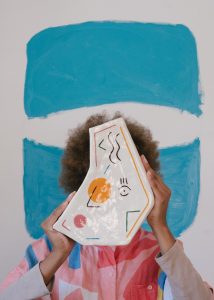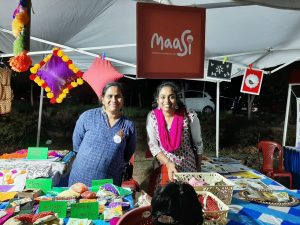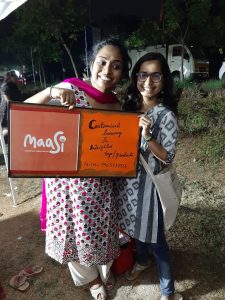Some days back, I got to know about a small and interesting enterprise called Maasi which helps people with special sensory needs through specially-designed products and services. I mean, most families engaged with Maasi are those with their children in the autism spectrum, although the products and services are suitable for people across ages with special sensory needs that also includes mental health issues. And how much do we even know about autism and how can we share that help through such small ventures? That’s what I asked myself before I found out that WHO estimates that worldwide one in 160 children has an ASD. That was the reason we decided to share the background story behind MAASI- the venture that takes you through some phases of Gouri’s (the founder of Maasi) life and her own first-hand experiences with autism as a condition that led them to bring forth the concept of MAASI. Today, MAASI helps several people along with Gouri’s own daughter grow through this journey in the best possible way.
Her birth and their first encounter with Autism:
In a conversation, Gouri goes back to the time when Jia* (her daughter) was born. She mentions that Jia had always looked perfectly fine back then, even though Jia was a C-Section baby. Children who are born through C-Section develop jaundice, which Jia had also developed when she was just two days old. It’s quite a general condition they have to go through, apart from being exposed to photo light. Gouri says, “See, when the child’s inside the womb it’s completely immersed in a fluid and when they come out they are still trying to figure out how to breathe, their lungs try to figure out how to take in air. It takes time for them to adapt. In this situation, I had to cover my child’s eye and put her into constant radiation day and night.
 Well, I am not a doctor but I am exposing a 2-day old child to such radiation and asking her to adjust.”
Well, I am not a doctor but I am exposing a 2-day old child to such radiation and asking her to adjust.”
Gouri goes on to clarify that she doesn’t declare that Jia had developed those sensory issues because of being exposed to the radiations, but still believes that those must be having some of the other repercussions, although, they don’t know enough to establish that. After all these radiation procedures were done, everything seemed fine for the next nine to ten months. Once Jia started learning all those little things, Gouri had kind of picked up that there was something different about her daughter and she tried to explain that to her paediatrician as well but most of the times she’d get reassurances stating that was her first time as a mother and Jia was doing just fine. After rejecting Gauri’s opinion several times her paediatrician had finally agreed to set up an appointment with a doctor who was supposedly the best Neuro-Pediatrician in India. He happened to be a classmate of their Pediatrician so she got them in touch with him. (This entire thing happened in Mumbai. Her daughter was born in Hyderabad but after 5 months they moved to Mumbai.)
“We finally met the doctor during his lunch hours. He held my daughter’s head and uplifted her and the minute he did that, she started crying and screaming like crazy. It didn’t take him much time to figure out and say that my daughter was autistic”, states Gauri. She still can’t recall what the doctor went on to say for the next 20-30 minutes after he declared Jia was autistic as she couldn’t stop sobbing. Later on, while she was able to talk to him again the doctor clearly instructed that even if Gauri was a working lady, she had to give it all up and be invested in taking care of Jia for the rest of her life. Although Gauri wasn’t working back then too, she had understood what her ambition for the rest of her life had to be. The next thing he asked her to do was to put her in a Montessori (Montessori is a method of education that is based on self-directed activity, hands-on learning, and collaborative play. In Montessori classrooms children make creative choices in their learning, while the classroom and the highly trained teacher offer age-appropriate activities to guide the process.)
Recognizing autism and its classic symptoms
 When asked about what all she had already known about Autism before this personal encounter, she goes on to say that she didn’t have much idea about it although she had started reading about it recently back then and could understand that her daughter was showing classic symptoms of it. Some of them included not being able to make eye contact, not responding when she called her by her name, and also, she would sit in a ‘W’ position. “She started doing a lot of things like recognizing things and saying bye to her father but then she stopped all of it, which is also a symptom of people with Spectrum. I was also reading about it all extensively. Then we put her in a school to see how she reacted and after her first birthday, we got her to her first therapy. Jia was around 18 months of age back then. It was an intervention therapy where they help the child to create eye contact and then respond to the needs of people around. These are like the most basic levels that children with the spectrum are taught. We started these sessions with an NGO in Mumbai called Ummeed, and we gave my daughter therapies for a good two years. It helped us immensely in the initial stages, and after 1 year we started on her Occupational Therapy. Later we moved back to Hyderabad and started her speech therapy.”
When asked about what all she had already known about Autism before this personal encounter, she goes on to say that she didn’t have much idea about it although she had started reading about it recently back then and could understand that her daughter was showing classic symptoms of it. Some of them included not being able to make eye contact, not responding when she called her by her name, and also, she would sit in a ‘W’ position. “She started doing a lot of things like recognizing things and saying bye to her father but then she stopped all of it, which is also a symptom of people with Spectrum. I was also reading about it all extensively. Then we put her in a school to see how she reacted and after her first birthday, we got her to her first therapy. Jia was around 18 months of age back then. It was an intervention therapy where they help the child to create eye contact and then respond to the needs of people around. These are like the most basic levels that children with the spectrum are taught. We started these sessions with an NGO in Mumbai called Ummeed, and we gave my daughter therapies for a good two years. It helped us immensely in the initial stages, and after 1 year we started on her Occupational Therapy. Later we moved back to Hyderabad and started her speech therapy.”
Schooling and the hustles
Gauri tells that they even tried to put Jia in a normal school, but her schooling experience had been awful. For the first school they tried, back there in Mumbai, they didn’t agree on keeping her, and the second school kept her although there was nothing much that she was able to do there. Jia would constantly roam around in the classroom and could never sit in one place as she hadn’t developed that tolerance to sit down- something which comes naturally to people like us. She explains how they had to break down every simple thing that a typical child would pick up on their own, and teach her bit by bit.
Discovering her sensory needs
 As far as Jia is concerned, she’s always been a tactile kid. Gauri explains that Jia likes touching different textures. And in fact, it was her sister or Jia’s maasi Prashanti who first noticed that it calms her down. “Jia would just go around touching sofa sets. If someone is wearing a saree she would go and run around them to touch it. So, my sister is very good at handcrafts. She initially realized that my daughter likes different textures so we could give her those and see how it goes. Like she has a favourite t-shirt which she would wear again and again even if it goes tight on her body. So what Prashanti did was, she picked all these favourite things and made her a pillow or a handkerchief or even things that we could spread on her bed. These were some of the stuff we could use out of the things which she liked. We got a clearer picture with the help of our therapist who further explained how much Jia likes textures like sand, grains (chole, rice, rawa), etc, and the more texture we provide her the better it would be”, says Gauri.
As far as Jia is concerned, she’s always been a tactile kid. Gauri explains that Jia likes touching different textures. And in fact, it was her sister or Jia’s maasi Prashanti who first noticed that it calms her down. “Jia would just go around touching sofa sets. If someone is wearing a saree she would go and run around them to touch it. So, my sister is very good at handcrafts. She initially realized that my daughter likes different textures so we could give her those and see how it goes. Like she has a favourite t-shirt which she would wear again and again even if it goes tight on her body. So what Prashanti did was, she picked all these favourite things and made her a pillow or a handkerchief or even things that we could spread on her bed. These were some of the stuff we could use out of the things which she liked. We got a clearer picture with the help of our therapist who further explained how much Jia likes textures like sand, grains (chole, rice, rawa), etc, and the more texture we provide her the better it would be”, says Gauri.
Why is it important to satisfy their sensory needs?
She continues to explain that their sensory needs need to be fulfilled because when these kids crave for it, they can’t focus on their surroundings and become socially cut-off. She marks this as the major reason why it gets difficult for kids like Jia to focus on anything else, capture things going around, and continue learning naturally as the other kids do. They can’t pick up social cues which in turn affects their language development, their interpersonal relationship gets affected, they get anxious in the presence of a lot of people and don’t know how to be social. It is challenging for children with the spectrum to develop imitation- something fundamental to learn the most basic things like speaking, eating, and reacting. Imitation brings out children’s very first social experiences, trying to behave or speak out or react like their parents or people around them. Although it takes a lot of effort to develop imitation in kids with spectrum just like her daughter developed it now after around more than two years of age.
Keys to take special care
 The initial days weren’t so easy. Jia’s maasi took the utmost care of her likes and dislikes. She started initially with small things and then advanced further so that keeping the same as a medium could teach her in the future too. All the textured stuff they use would help to keep the kid busy and then to teach her the little things we call basic life skills. It works out in a sandwich model. You give the kid what they want, indulge them in something, and then teach them, and after that again when they feel irritated you give them what they want so they calm down. It should be a list of at least their 10 favourite things because nothing can keep them focused for more than 15 mins, that’s what Gauri feels. She goes on to say, “I think everybody’s journey is different, but I know about my friends who are like me. They have gone through a huge amount of research and the entire day they would be struggling through therapy and by the time their child sleeps, they would be on the internet studying all about it, till like 2-3 in the night, figuring out what all they can do with their children’s diet, their therapies, simple life-skills, potty training, and all that can be done better. So even I also went through all of it. I went through a lot of training because there’s nothing that you know generally about raising children that would work for the children with spectrum. So all these things help a lot- the training, the therapy, the therapist, support from your friends and family, and accepting the child the way they are.”
The initial days weren’t so easy. Jia’s maasi took the utmost care of her likes and dislikes. She started initially with small things and then advanced further so that keeping the same as a medium could teach her in the future too. All the textured stuff they use would help to keep the kid busy and then to teach her the little things we call basic life skills. It works out in a sandwich model. You give the kid what they want, indulge them in something, and then teach them, and after that again when they feel irritated you give them what they want so they calm down. It should be a list of at least their 10 favourite things because nothing can keep them focused for more than 15 mins, that’s what Gauri feels. She goes on to say, “I think everybody’s journey is different, but I know about my friends who are like me. They have gone through a huge amount of research and the entire day they would be struggling through therapy and by the time their child sleeps, they would be on the internet studying all about it, till like 2-3 in the night, figuring out what all they can do with their children’s diet, their therapies, simple life-skills, potty training, and all that can be done better. So even I also went through all of it. I went through a lot of training because there’s nothing that you know generally about raising children that would work for the children with spectrum. So all these things help a lot- the training, the therapy, the therapist, support from your friends and family, and accepting the child the way they are.”
Acceptance- the journey from unlearning to learning again
Most people don’t accept the fact that their kid is autistic. They go in complete denial of it. Even if they do accept, they don’t try to understand what can make them live a better life. There’s a lot of learning and unlearning involved in the process of understanding a kid with a spectrum. While Jia was struggling in her mind to figure out her sensory needs and how to get her order in life, Gauri had been learning about her. She understands that her struggles were simply indescribable but through time, she figured her way and Gauri understood better what was happening so it got a bit balanced. Gauri and Prashanti’s successful attempts to understand, teach, and implement all of it have given them a direction. Jia’s maasi has helped other families and their kids with supportive handmade products based on their sensory needs. All of this has happened over a while, and they’ve been really happy to see that their efforts are working, and helping them and others deal with it better. It takes time and patience to understand the kid, the requirements, the behaviour. It’s a kind of mystery box. Every day you get to know something new about the kid, their requirements, and what makes them feel better. It’s not just one checkbox to be ticked. There are multiple checkboxes that as a whole ensure that it will not be a rough ride. It’s all equally important from understanding their needs to taking training for them to therapy sessions to always being able to learn new things about them and taking care of their needs – their sensory needs or diet. Some parents understand the needs of their kids, others don’t. Some can’t afford all these treatments too.
The inception of MAASI
Little toy products that Jia carried with her kept her calm and it slowly became a topic of conversation in their circle. That is how the close groups of parents of kids with ASD started reaching out to Gauri to seek similar products for their kids and eventually Gauri and Prashanti’s methods or products they use for Jia started being noticed. For kids with Spectrum, it gets very difficult to make the transition from doing one thing to the other, like when the kid is sitting it takes a lot of convincing, tantrums and efforts to make them get up if you have to drive to a place in a while or have to go meet the therapist or just have to make them sleep. People around them and a lot of mothers like her had noticed that gradually Jia was coping up well with these transitions. The reason was simple, Gauri understood that the things that calm her down are meant to be kept with her at all times and she gave it to her every time she used to crave the textures. It makes the management easier, and while the kid is busy it’s easier to make the transitions without shifting their complete focus to what they need to do next. Other parents started reaching out to Gauri asking her to try these with their kids as well. And in the process of helping Gauri had come to know about another range of possibilities and conditions that exist and how they vary for each person with ASD. As her suggestions worked, more calls came in asking for suggestions and products. Prashanti didn’t attend the calls and meetings with the parents and caregivers directly but it was Gauri who started that. Gauri asked them about the current therapies, behaviour, and procedures they’re undergoing, the child’s likes and dislikes, and compared the cases with what she experiences to identify the right approach.  In a lot of cases, Gauri has to tell the parents that in a particular area they need to work more with the therapist because she isn’t the right person to suggest everything, in some cases, she has to identify and make parents understand that the products that they have might not fulfil their kid’s needs and might be of no use for them. It all depends on how different each case is and when they understand that the kid requires a particular kind of product, be it different kinds of brushes, or weighted blankets, or some textured mats, or anything made specially to meet that kid’s requirement, Gauri understands it with the help of the kid’s direct caregivers and then Prashanti goes ahead and makes that customized product. The most important thing is if those products are ordered online from some other place they need to be imported from other countries and it takes many days to reach people. The next thing is since the products they ordered are imported they are expensive and Gauri has personally experienced that if the product being so costly doesn’t work, it all goes to waste since it is all generalized and the kid’s requirement may not be fulfilled. Most of the Indian parents can’t afford these products and so the time Prashanti’s products started working for Jia, that was a sigh of relief for their family. Gauri elaborates on how they started being approached. She says, ”When people with ASD started reaching us, we were amazed and more than that, happy to help them. Though challenges were there, like how to make time for it despite our busy schedule, we gave it a chance and stepped in. When parents came across these handmade products Prashanti was making, they were keen on knowing how it works and how it would provide comfort to people. Moreover, our products weren’t limited only to Spectrum, they were extended to people with anxiety issues too.’’
In a lot of cases, Gauri has to tell the parents that in a particular area they need to work more with the therapist because she isn’t the right person to suggest everything, in some cases, she has to identify and make parents understand that the products that they have might not fulfil their kid’s needs and might be of no use for them. It all depends on how different each case is and when they understand that the kid requires a particular kind of product, be it different kinds of brushes, or weighted blankets, or some textured mats, or anything made specially to meet that kid’s requirement, Gauri understands it with the help of the kid’s direct caregivers and then Prashanti goes ahead and makes that customized product. The most important thing is if those products are ordered online from some other place they need to be imported from other countries and it takes many days to reach people. The next thing is since the products they ordered are imported they are expensive and Gauri has personally experienced that if the product being so costly doesn’t work, it all goes to waste since it is all generalized and the kid’s requirement may not be fulfilled. Most of the Indian parents can’t afford these products and so the time Prashanti’s products started working for Jia, that was a sigh of relief for their family. Gauri elaborates on how they started being approached. She says, ”When people with ASD started reaching us, we were amazed and more than that, happy to help them. Though challenges were there, like how to make time for it despite our busy schedule, we gave it a chance and stepped in. When parents came across these handmade products Prashanti was making, they were keen on knowing how it works and how it would provide comfort to people. Moreover, our products weren’t limited only to Spectrum, they were extended to people with anxiety issues too.’’
How MAASI helps (Get in touch- https://maasi.co.in)
Let’s give you a walkthrough of the steps they follow through the process. The things don’t work traditionally here, it involves a conversation from both the ends and then the final product comes into the picture. The parents or the immediate caregivers of people with Spectrum talk to them, share pictures, or tell them about any rough idea they have in mind related to the product keeping in mind their likes and dislikes. The immediate caregivers must be involved so that the requirements can be completely understood. Maximum information can be gathered only that way. They ask about the designs available, may be of alphabets, shapes, or anything; the textures, the colours, etc. Parents might tell them what colour they like the most, what textures attract them, and every minute detail that would make the product more helpful for them. “Sometimes the process reverses and we provide them with all the details and they choose accordingly. That’s how we differ from others and this customization leads to exploring new possibilities and a wider range of products. On our part just to be sure we display the products with all available textures and make sure that the kid responds well to it”, adds Gauri. The most important question is always, what issue the child is facing. If a child has sleeping issues they go with weighted eye-masks or weighted blankets. If they have a problem sitting in the same place, weighted lap pads help. These details are mentioned on the website. They guide the caregivers mainly on issues around Attention Deficit (Hyperactivity) Disorder (ADD/ADHD), Autism Spectrum Disorder( ASD), Sensory Processing Disorder( SPD). After all these procedures a product is customized and delivered. That’s how they share knowledge and learn new things every time.
Team MAASI:
“Maasi began as a means to provide aids to kids with special needs. Over time, we realized that it should reach a mass of people so that needs are satisfied within time. As in our part, we had seen the struggles, how it takes time to research the desired product, and the time required in transportation and the procedures. Keeping all the adversities in mind we wanted to create awareness and make people aware of sensory and weighted products. Initially, we started by keeping stalls every month, and then we decided to promote them on digital and social platforms. Thus, with many internal meetings, reaching out to experts, after all of the hard work done in the background for almost a year the website of Maasi came live globally. After the launch of the website Maasi has been able to reach more people, and now through all social media platforms we try to create awareness about Autism, how to deal with it, and most importantly how weighted and sensory products help to deal with various issues and how they customize them accordingly.  Maasi has started putting their stalls with more frequency today with at least one stall per month (currently based in Hyderabad in stores and delivery remains PAN India online). Every new product is being updated on the website. We are planning to collaborate with people so we have every resource present on one site. Recently we organized a workshop from our Caterpillar Club, where some of our friends helped us to teach art and craft to the kids. Even an Autism Walk was also recently planned which would make kids walk with the help of these products. Maasi is trying to bring changes in the life of kids with spectrum via workshops and various events organized to make them more comfortable socially. Maasi doesn’t want to put any constraints on itself by just being a product-based company, rather we want to transform as a smaller version of a society focused on this idea of being helping hands, always ready to help people with spectrum. You too can play your part in the chain by listening to their stories, spreading their words, and allowing them to see a better life for themselves.”
Maasi has started putting their stalls with more frequency today with at least one stall per month (currently based in Hyderabad in stores and delivery remains PAN India online). Every new product is being updated on the website. We are planning to collaborate with people so we have every resource present on one site. Recently we organized a workshop from our Caterpillar Club, where some of our friends helped us to teach art and craft to the kids. Even an Autism Walk was also recently planned which would make kids walk with the help of these products. Maasi is trying to bring changes in the life of kids with spectrum via workshops and various events organized to make them more comfortable socially. Maasi doesn’t want to put any constraints on itself by just being a product-based company, rather we want to transform as a smaller version of a society focused on this idea of being helping hands, always ready to help people with spectrum. You too can play your part in the chain by listening to their stories, spreading their words, and allowing them to see a better life for themselves.”
Visit their website now and know more about how you can help someone in need by introducing them to MAASI: https://maasi.co.in
Every kid with Spectrum can learn and grow, it’s just the right approach that needs to be followed through. Parents, as well as society, need to be inclusive of them. Our education system needs to help them learn. Maasi can help make a difference only when we play our part, only when we learn something from the story and try to help these kids lead a better life- something every individual deserves to see. Maasi is a helping hand we have, to deal with ASD and other conditions, and this story is shared to bring awareness about all of it. I hope it helps.
Author-
Bhavna Dubey | Editor-in-Chief, Telloway

